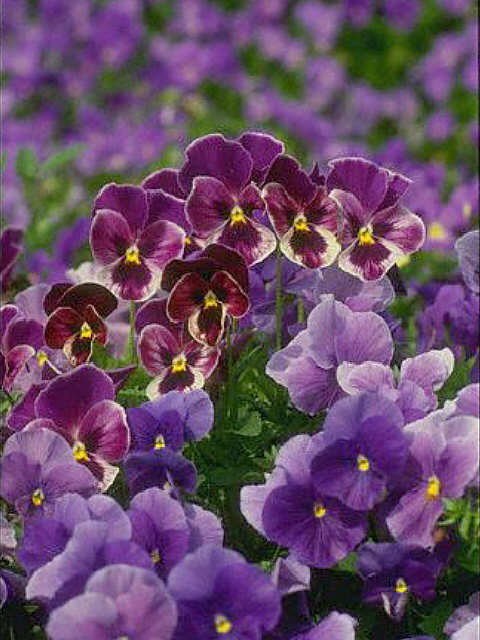March is supposed to begin as either a lion or a lamb. No one ever said anything about a day at the beach, but that is exactly how March presented itself this year, and the summer-like sizzle lit a fire under many gardeners. It sent us rushing to the nursery even before the pansies were ready to come out of the greenhouse.
I spent those fleeting days of our pre-spring summer potting pansies in shades of burgundy and blue. They make a perfect foil for the overstuffed buckets of daffodils that I potted in the fall. My five-year-old daughter Sierra went with me to the nursery. She was smitten by the row upon row of flowers in nearly every color of the rainbow. She wanted to bring home some of each, but finally settled on a cheerful yellow with a dark face. Even before she had hers potted and watered, Sierra was talking to her pansy like a beloved pet. I wondered if she would be able to leave it outside overnight.
 |
| Purple Pansies |
Putting the pansies in pots rather than garden beds will
make it easier to protect them from spring's fickle
temperament. Actually they are very cold-hardy and will
stand up to most of what March dishes out, but if winter
musters a true comeback, with temperatures well below
freezing, I will be able to huddle them together in the
carport..
Once spring is here to stay, I will have to worry about
the wilting heat to which pansies always succumb. On the
other hand, by then there will be so many more flowers
blooming that the pansies will be allowed to fade away
with little acknowledgment or thanks.
The pansy is both beneficiary and victim of its own
charm and popularity. Because it is the earliest flower
available in the spring and one of the last of the fall
bedding plants, there is hardly a gardener who can
resist it. During mild winters or in sheltered planters,
pansies in our area will even bloom well into winter.
They are available in a startling array of colors, and
the center "blotch," more endearingly called
the face, in many cultivars evokes the "little
maids all in a row" of Contrary Mary's garden. But
when the temperatures rise, the competition heats up
too, and with so many more flowers to choose from,
gardeners suddenly see the pansy as all too common.
The pansy (viola x wittrockiana) is a complex hybrid of three or four viola species. It entered the gardening world almost by accident in the early 1800s. European plant breeders were busy crossing various species of viola in an effort to "improve" the English wildling,
Johnny-jump-up (v. tricolor). William Thompson, who is considered the father of the modern pansy, came "face to face" with the first blotched pansy in a forgotten corner of his greenhouse. It was on the flower of a self-sown seedling, making its precise heritage a bit mysterious. It was an instant hit and plant breeders have been crossing and re-crossing it ever since.
The pansy first found favor among British
"florists." The word florist was then used to
describe plant breeders who devoted their efforts to
producing a perfect flower, matching ideal standards for
size, shape, symmetry and color. This is when societies
devoted to specific flowers were formed and competitions
and elaborate shows were held to find and reward the
growers with the best show flowers.
In the years since, breeders have continued to develop
new hues and color combinations. Look for Halloween
colors this fall. There is even a variety bred to have a
face resembling Groucho Marx, though to me all pansy
faces look more like my neighbor's West Highland
terrier. Maybe that's because I would much rather have a
pot of happy puppies looking up at me than the
mischievous Marx.
Most recently an emphasis has been placed on developing
quality characteristics like vigor, heat tolerance and
bloom time. There are cultivar series especially
designed for spring planting and others bred to bloom
through the winter.
While growers continue to improve the pansy, I keep
running into gardeners who seem to have had too much of
a good thing. One went so far as to call the
commercialization and year 'round availability of this
classic flower "down right sinful." I felt a
twinge of guilt when I carried four flats away from the
nursery.
Only a week after we potted our pansies, March came
roaring back with lashing winds and biting cold. The
pansies' faces were all downcast. The soil they were in
was frozen hard, but as the day warmed slightly, they
raised their puppy-dog faces again. Such loyalty only
comes from true friends and beloved pets. As I walked by
Sierra's pansy, I was tempted to bring it into the house
with me.